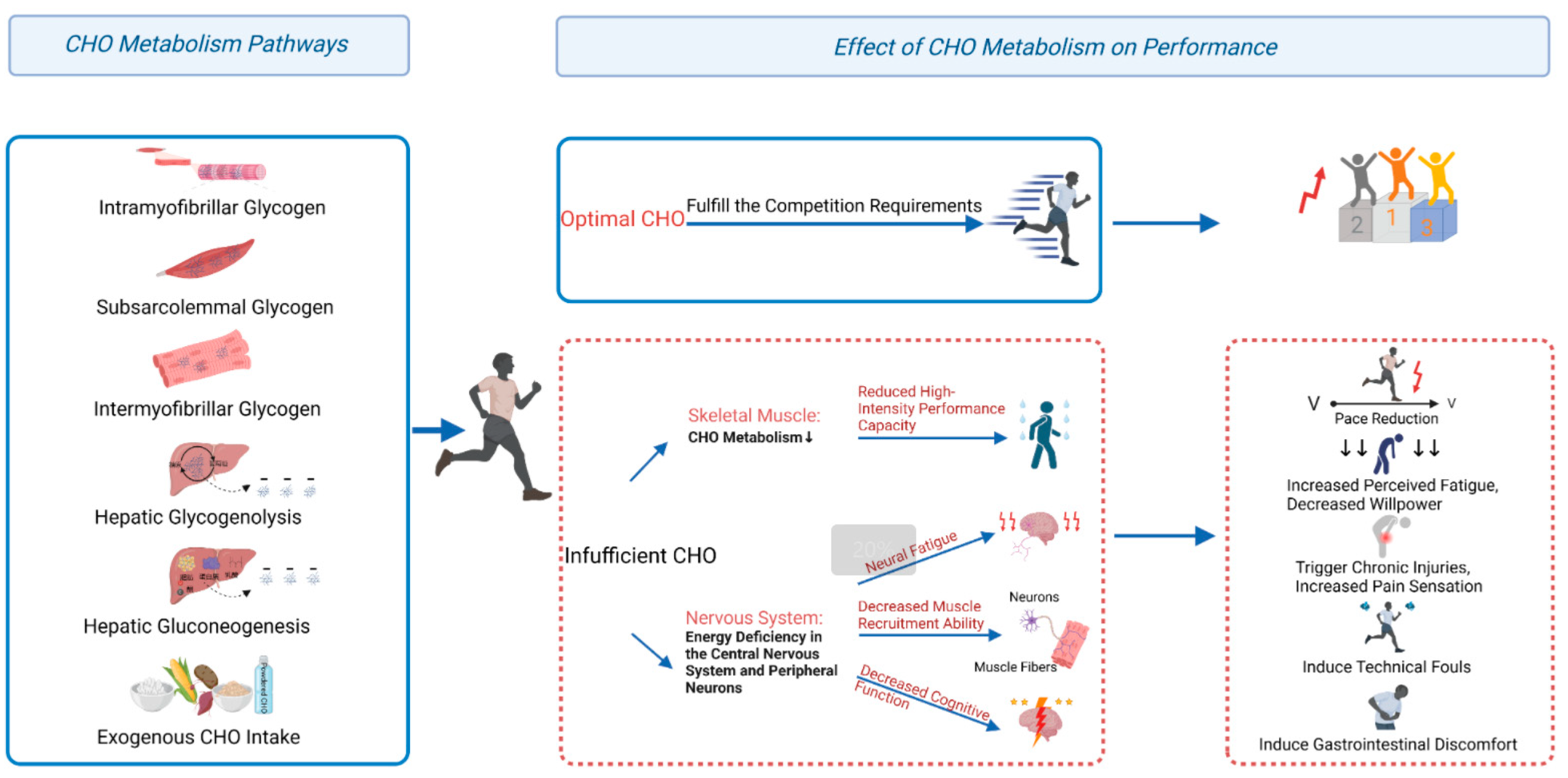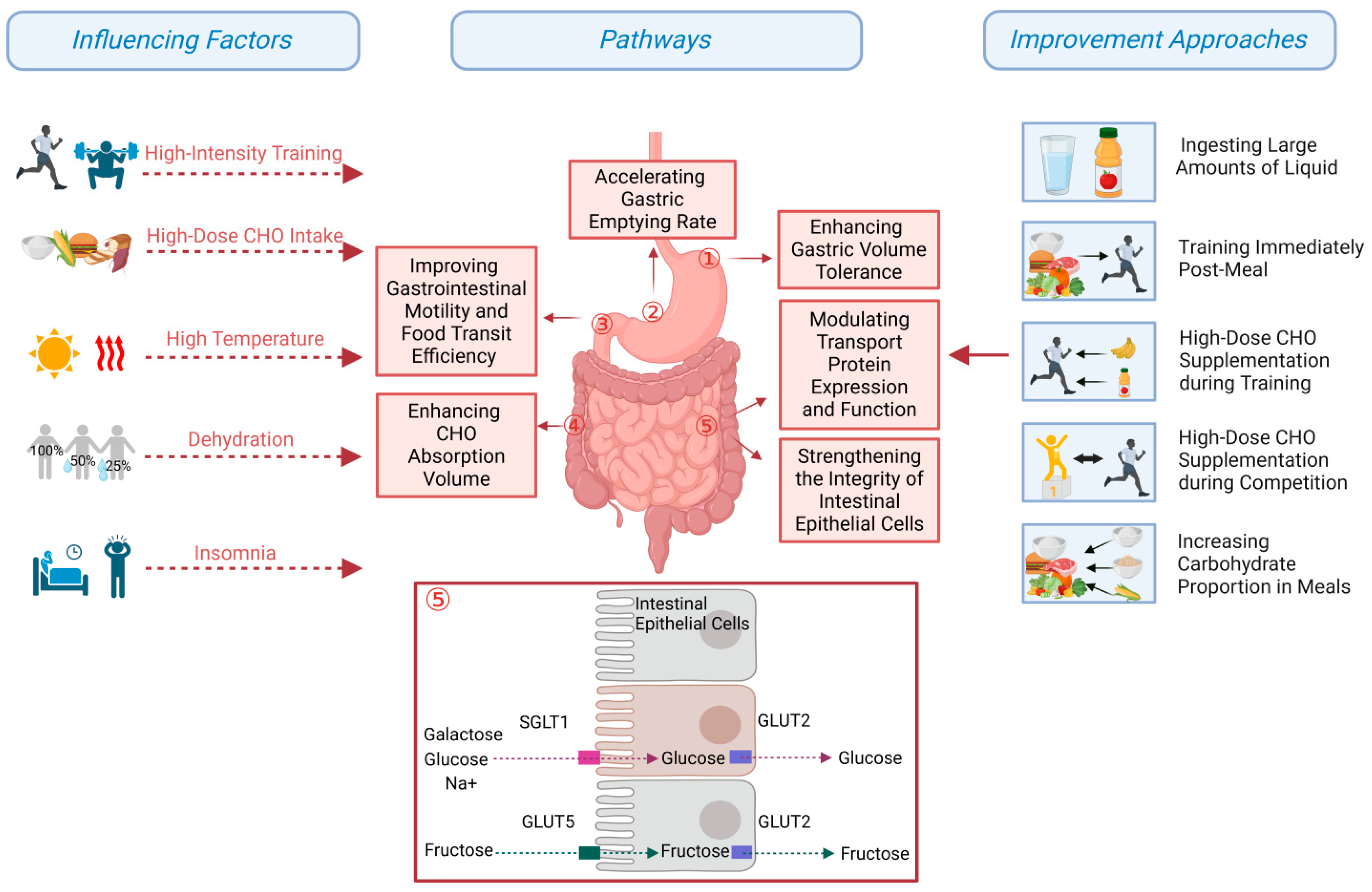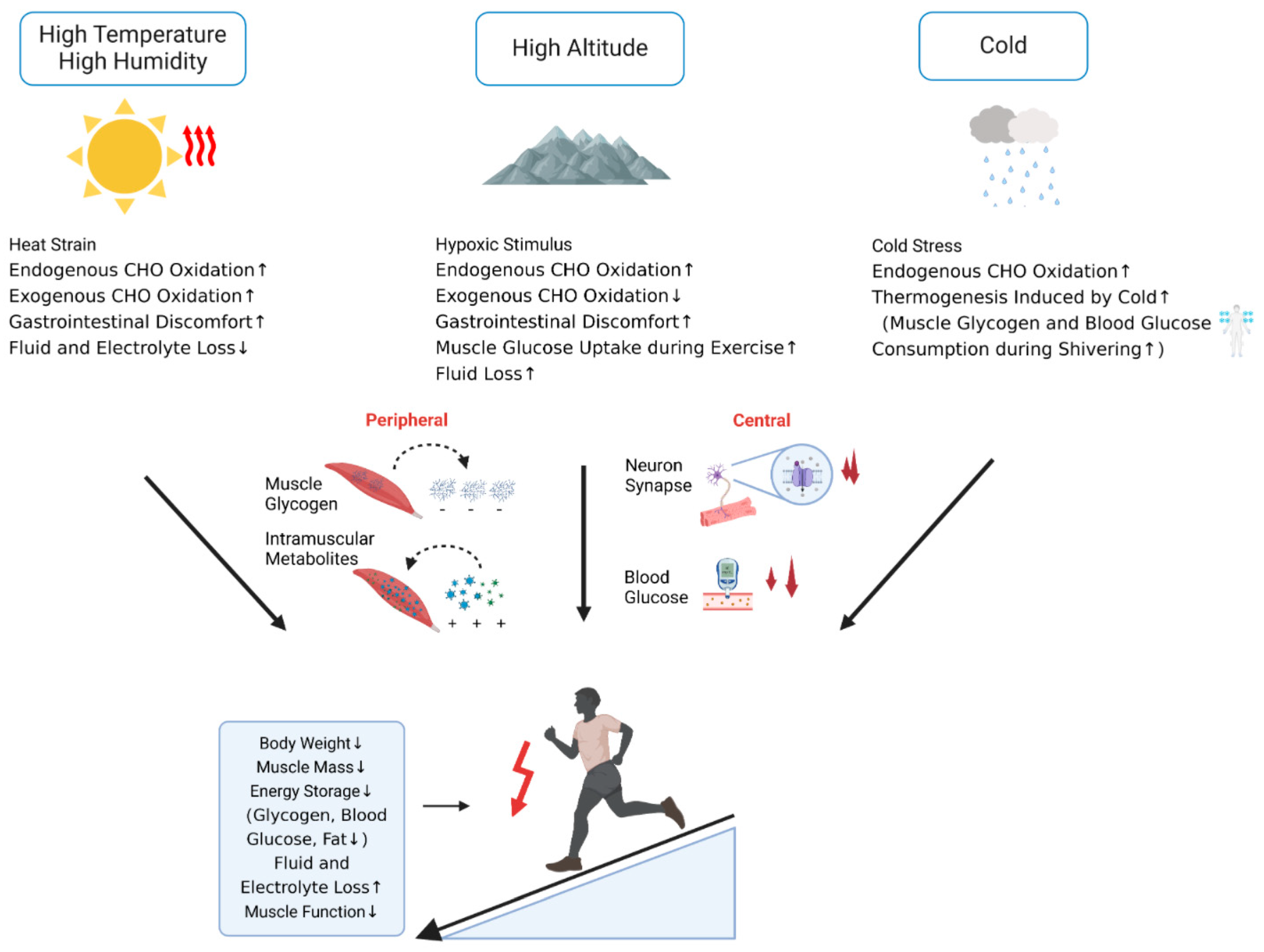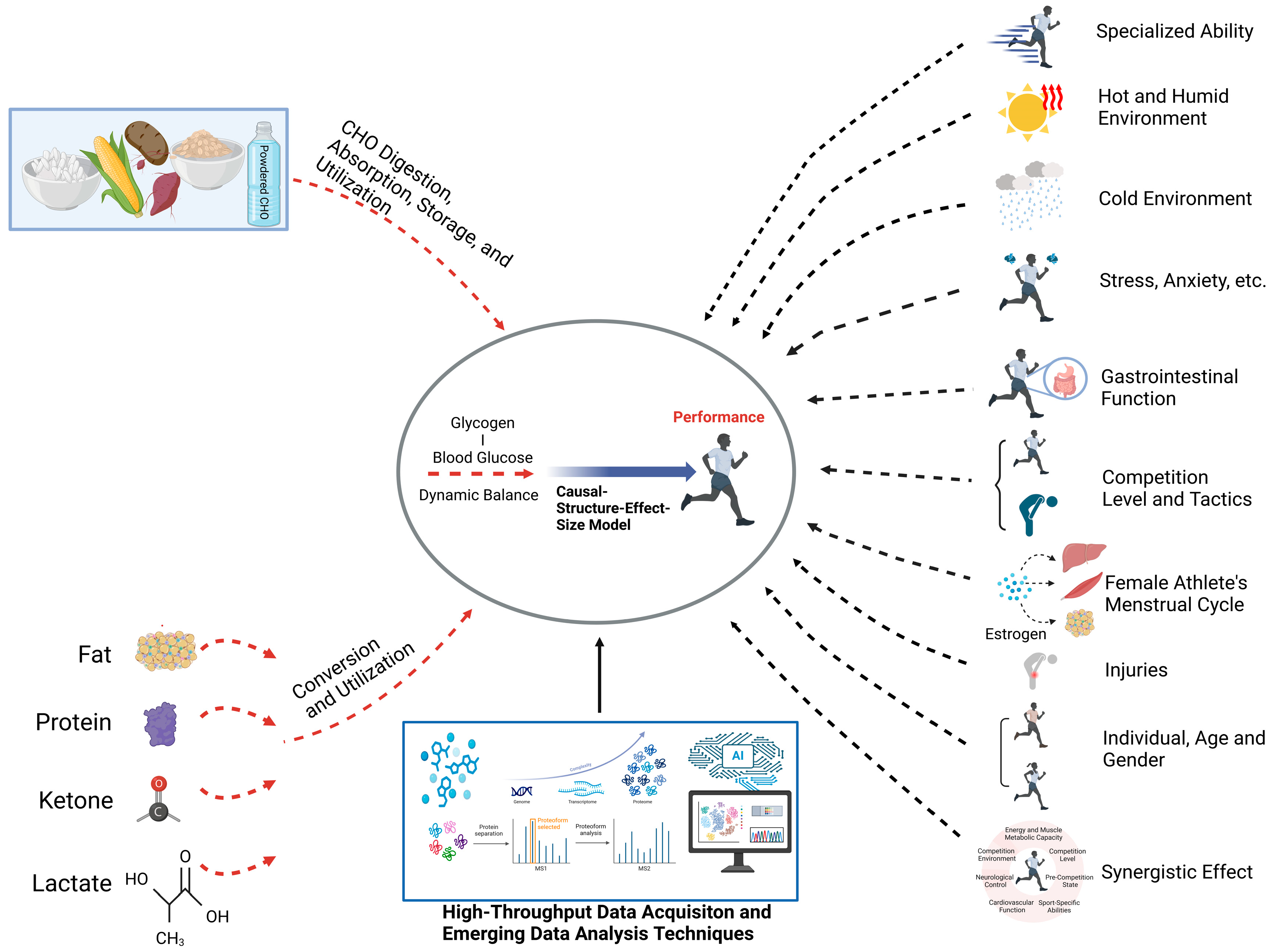A Review of Carbohydrate Supplementation Approaches and Strategies for Optimizing Performance in Elite Long-Distance Endurance
Abstract
1. Introduction
2. Carbohydrate Supplementation Approaches
2.1. Pre-Competition
2.2. During Competition
2.3. Post-Competition
3. Carbohydrate Supplementation Strategies
3.1. Carbohydrate Supplementation Strategies Based on Carbohydrate Properties
3.2. Carbohydrate Supplementation Strategies Based on the Synergistic Enhancement Benefits of Protein, Sodium, and Caffeine
3.3. Carbohydrate Supplementation Strategies Based on Enhancing Gastrointestinal Function
3.4. Carbohydrate Supplementation Strategies Based on Individual Differences in Age and Gender
3.5. Carbohydrate Supplementation Strategies in Extreme Environments
3.5.1. Carbohydrate Supplementation Strategies in High-Altitude Environments
3.5.2. Carbohydrate Supplementation Strategies in Hot and Humid Environments
3.5.3. Carbohydrate Supplementation Strategies in Cold Environments
3.6. Carbohydrate Supplementation Strategies Under Competitive Anxiety
4. Limitations and Future Research Directions
- (1)
- The energy requirements and carbohydrate metabolism characteristics under different competition levels, environments, specialized abilities, and athletic states, along with corresponding carbohydrate supplementation strategies.
- (2)
- The capacity for carbohydrate-based energy provision during major competitions, the optimal glycogen threshold, the appropriate blood glucose range, and real-time monitoring methods for glycogen storage and depletion, all of which are crucial for enhancing endurance performance.
- (3)
- The causal relationships between athletes’ specialized abilities, carbohydrate metabolism, and gastrointestinal function, and the development of predictive models for competition performance based on these relationships.
- (4)
- The molecular mechanisms of carbohydrate transport, storage, and utilization, as well as their interaction with other energy substrates (e.g., fats, proteins, ketones, and lactate) in energy metabolism. This includes precise glycogen storage patterns in subsarcolemmal, inter-myofibrillar, and intra-myofibrillar regions.
5. Conclusions
Author Contributions
Funding
Conflicts of Interest
Abbreviations
| HTW | Hitting the wall |
| SGLT1 | Sodium–glucose cotransporter 1 |
| GLUT5 | Glucose transporter protein 5 |
| GI | Glycemic index |
| EIGS | Exercise-induced gastrointestinal syndrome |
| CGM | Glucose monitoring |
| WGBT | Wet Bulb Globe Temperature |
| HPA | Hypothalamic–pituitary–adrenal |
| CRH | Corticotropin-releasing hormone |
| ACTH | Adrenocorticotropic hormone |
| ATP | Adenosine 5′-triphosphate |
| GL | Low glycemic load |
References
- Brooks, G.A. The Precious Few Grams of Glucose During Exercise. Int. J. Mol. Sci. 2020, 21, 5733. [Google Scholar] [CrossRef]
- Flockhart, M.; Larsen, F.J. Continuous Glucose Monitoring in Endurance Athletes: Interpretation and Relevance of Measurements for Improving Performance and Health. Sports Med. 2024, 54, 247–255. [Google Scholar] [CrossRef] [PubMed]
- Hargreaves, M.; Spriet, L.L. Skeletal muscle energy metabolism during exercise. Nat. Metab. 2020, 2, 817–828. [Google Scholar] [CrossRef] [PubMed]
- Jensen, R.; Ørtenblad, N.; Stausholm, M.H.; Skjaerbaek, M.C.; Larsen, D.N.; Hansen, M.; Holmberg, H.C.; Plomgaard, P.; Nielsen, J. Heterogeneity in subcellular muscle glycogen utilisation during exercise impacts endurance capacity in men. J. Physiol. 2020, 598, 4271–4292. [Google Scholar] [CrossRef] [PubMed]
- Hearris, M.A.; Hammond, K.M.; Seaborne, R.A.; Stocks, B.; Shepherd, S.O.; Philp, A.; Sharples, A.P.; Morton, J.P.; Louis, J.B. Graded reductions in preexercise muscle glycogen impair exercise capacity but do not augment skeletal muscle cell signaling: Implications for CHO periodization. J. Appl. Physiol. 2019, 126, 1587–1597. [Google Scholar] [CrossRef]
- Katz, A. A century of exercise physiology: Key concepts in regulation of glycogen metabolism in skeletal muscle. Eur. J. Appl. Physiol. 2022, 122, 1751–1772. [Google Scholar] [CrossRef]
- Ishihara, K.; Uchiyama, N.; Kizaki, S.; Mori, E.; Nonaka, T.; Oneda, H. Application of Continuous Glucose Monitoring for Assessment of Individual Carbohydrate Requirement during Ultramarathon Race. Nutrients 2020, 12, 1121. [Google Scholar] [CrossRef]
- Amiel, S.A. The consequences of hypoglycaemia. Diabetologia 2021, 64, 963–970. [Google Scholar] [CrossRef]
- Shulman, R.G.; Rothman, D.L. The “glycogen shunt” in exercising muscle: A role for glycogen in muscle energetics and fatigue. Proc. Natl. Acad. Sci. USA 2001, 98, 457–461. [Google Scholar] [CrossRef]
- Bandiera, D.; Racinais, S.; Garrandes, F.; Adami, P.E.; Bermon, S.; Pitsiladis, Y.P.; Tessitore, A. Heat-related risk at Paris 2024: A proposal for classification and review of International Federations policies. Br. J. Sports Med. 2024, 58, 860–869. [Google Scholar] [CrossRef]
- Dupont, A.C.; Tooth, C.; Brocherie, F.; Racinais, S.; Bouten, J. Recommendations and regulations for sport events in the heat: ReFORM summary of the International Olympic Committee’s consensus statement. Br. J. Sports Med. 2025. ahead of print. [Google Scholar] [CrossRef] [PubMed]
- Naderi, A.; Gobbi, N.; Ali, A.; Berjisian, E.; Hamidvand, A.; Forbes, S.C.; Koozehchian, M.S.; Karayigit, R.; Saunders, B. Carbohydrates and Endurance Exercise: A Narrative Review of a Food First Approach. Nutrients 2023, 15, 1367. [Google Scholar] [CrossRef] [PubMed]
- Kerksick, C.M.; Wilborn, C.D.; Roberts, M.D.; Smith-Ryan, A.; Kleiner, S.M.; Jäger, R.; Collins, R.; Cooke, M.; Davis, J.N.; Galvan, E.; et al. ISSN exercise & sports nutrition review update: Research & recommendations. J. Int. Soc. Sports Nutr. 2018, 15, 38. [Google Scholar] [PubMed]
- Rothschild, J.A.; Kilding, A.E.; Plews, D.J. What Should I Eat before Exercise? Pre-Exercise Nutrition and the Response to Endurance Exercise: Current Prospective and Future Directions. Nutrients 2020, 12, 3473. [Google Scholar] [CrossRef]
- Burke, L.M.; Castell, L.M.; Casa, D.J.; Close, G.L.; Costa, R.J.S.; Desbrow, B.; Halson, S.L.; Lis, D.M.; Melin, A.K.; Peeling, P.; et al. International Association of Athletics Federations Consensus Statement 2019: Nutrition for Athletics. Int. J. Sport Nutr. Exerc. Metab. 2019, 29, 73–84. [Google Scholar] [CrossRef]
- Metcalfe, R.S.; Thomas, M.; Lamb, C.; Chowdhury, E.A. Omission of a carbohydrate-rich breakfast impairs evening endurance exercise performance despite complete dietary compensation at lunch. Eur. J. Sport. Sci. 2021, 21, 1013–1021. [Google Scholar] [CrossRef]
- Cermak, N.M.; van Loon, L.J. The use of carbohydrates during exercise as an ergogenic aid. Sports Med. 2013, 43, 1139–1155. [Google Scholar] [CrossRef]
- Mata, F.; Valenzuela, P.L.; Gimenez, J.; Tur, C.; Ferreria, D.; Domínguez, R.; Sanchez-Oliver, A.J.; Martínez Sanz, J.M. Carbohydrate Availability and Physical Performance: Physiological Overview and Practical Recommendations. Nutrients 2019, 11, 1084. [Google Scholar] [CrossRef]
- Podlogar, T.; Wallis, G.A. New Horizons in Carbohydrate Research and Application for Endurance Athletes. Sports Med. 2022, 52 (Suppl. S1), 5–23. [Google Scholar] [CrossRef]
- Rowlands, D.S.; Houltham, S.; Musa-Veloso, K.; Brown, F.; Paulionis, L.; Bailey, D. Fructose-Glucose Composite Carbohydrates and Endurance Performance: Critical Review and Future Perspectives. Sports Med. 2015, 45, 1561–1576. [Google Scholar] [CrossRef]
- Nikolaidis, P.T.; Veniamakis, E.; Rosemann, T.; Knechtle, B. Nutrition in Ultra-Endurance: State of the Art. Nutrients 2018, 10, 1995. [Google Scholar] [CrossRef] [PubMed]
- Podlogar, T.; Bokal, Š.; Cirnski, S.; Wallis, G.A. Increased exogenous but unaltered endogenous carbohydrate oxidation with combined fructose-maltodextrin ingested at 120 g h−1 versus 90 g h−1 at different ratios. Eur. J. Appl. Physiol. 2022, 122, 2393–2401. [Google Scholar] [CrossRef]
- King, A.J.; Etxebarria, N.; Ross, M.L.; Garvican-Lewis, L.; Heikura, I.A.; McKay, A.K.A.; Tee, N.; Forbes, S.F.; Beard, N.A.; Saunders, P.U.; et al. Short-Term Very High Carbohydrate Diet and Gut-Training Have Minor Effects on Gastrointestinal Status and Performance in Highly Trained Endurance Athletes. Nutrients 2022, 14, 1929. [Google Scholar] [CrossRef] [PubMed]
- Roberts, S.; Desbrow, B.; Grant, G.; Anoopkumar-Dukie, S.; Leveritt, M. Glycemic response to carbohydrate and the effects of exercise and protein. Nutrition 2013, 29, 881–885. [Google Scholar] [CrossRef] [PubMed]
- Ramonas, A.; Laursen, P.B.; Williden, M.; Chang, W.L.; Kilding, A.E. Carbohydrate intake before and during high intensity exercise with reduced muscle glycogen availability affects the speed of muscle reoxygenation and performance. Eur. J. Appl. Physiol. 2023, 123, 1479–1494. [Google Scholar] [CrossRef]
- Coyle, E.F.; Coggan, A.R.; Hemmert, M.K.; Ivy, J.L. Muscle glycogen utilization during prolonged strenuous exercise when fed carbohydrate. J. Appl. Physiol. 1986, 61, 165–172. [Google Scholar] [CrossRef]
- Murray, B.; Rosenbloom, C. Fundamentals of glycogen metabolism for coaches and athletes. Nutr. Rev. 2018, 76, 243–259. [Google Scholar] [CrossRef]
- Namma-Motonaga, K.; Kondo, E.; Osawa, T.; Shiose, K.; Kamei, A.; Taguchi, M.; Takahashi, H. Effect of Different Carbohydrate Intakes within 24 Hours after Glycogen Depletion on Muscle Glycogen Recovery in Japanese Endurance Athletes. Nutrients 2022, 14, 1320. [Google Scholar] [CrossRef]
- Burke, L.M.; van Loon, L.J.C.; Hawley, J.A. Postexercise muscle glycogen resynthesis in humans. J. Appl. Physiol. 2017, 122, 1055–1067. [Google Scholar] [CrossRef]
- Alghannam, A.F.; Gonzalez, J.T.; Betts, J.A. Restoration of Muscle Glycogen and Functional Capacity: Role of Post-Exercise Carbohydrate and Protein Co-Ingestion. Nutrients 2018, 10, 253. [Google Scholar] [CrossRef]
- Richter, E.A.; Sylow, L.; Hargreaves, M. Interactions between insulin and exercise. Biochem. J. 2021, 478, 3827–3846. [Google Scholar] [CrossRef] [PubMed]
- Bonilla, D.A.; Pérez-Idárraga, A.; Odriozola-Martínez, A.; Kreider, R.B. The 4R’s Framework of Nutritional Strategies for Post-Exercise Recovery: A Review with Emphasis on New Generation of Carbohydrates. Int. J. Environ. Res. Public Health 2020, 18, 103. [Google Scholar] [CrossRef]
- Jeukendrup, A.E. Training the Gut for Athletes. Sports Med. 2017, 47 (Suppl S1), 101–110. [Google Scholar] [CrossRef] [PubMed]
- Malone, J.J.; Hulton, A.T.; MacLaren, D.P.M. Exogenous carbohydrate and regulation of muscle carbohydrate utilisation during exercise. Eur. J. Appl. Physiol. 2021, 121, 1255–1269. [Google Scholar] [CrossRef]
- Liang, Y.; Chen, Y.; Yang, F.; Jensen, J.; Gao, R.; Yi, L.; Qiu, J. Effects of carbohydrate and protein supplement strategies on endurance capacity and muscle damage of endurance runners: A double blind, controlled crossover trial. J. Int. Soc. Sports Nutr. 2022, 19, 623–637. [Google Scholar] [CrossRef] [PubMed]
- Kerksick, C.M.; Arent, S.; Schoenfeld, B.J.; Stout, J.R.; Campbell, B.; Wilborn, C.D.; Taylor, L.; Kalman, D.; Smith-Ryan, A.E.; Kreider, R.B.; et al. International society of sports nutrition position stand: Nutrient timing. J. Int. Soc. Sports Nutr. 2017, 14, 33. [Google Scholar] [CrossRef]
- Dahl, M.A.; Areta, J.L.; Jeppesen, P.B.; Birk, J.B.; Johansen, E.I.; Ingemann-Hansen, T.; Hansen, M.; Skålhegg, B.S.; Ivy, J.L.; Wojtaszewski, J.F.P.; et al. Coingestion of protein and carbohydrate in the early recovery phase, compared with carbohydrate only, improves endurance performance despite similar glycogen degradation and AMPK phosphorylation. J. Appl. Physiol. 2020, 129, 297–310. [Google Scholar] [CrossRef]
- Veniamakis, E.; Kaplanis, G.; Voulgaris, P.; Nikolaidis, P.T. Effects of Sodium Intake on Health and Performance in Endurance and Ultra-Endurance Sports. Int. J. Environ. Res. Public Health 2022, 19, 3651. [Google Scholar] [CrossRef]
- Klingert, M.; Nikolaidis, P.T.; Weiss, K.; Thuany, M.; Chlíbková, D.; Knechtle, B. Exercise-Associated Hyponatremia in Marathon Runners. J. Clin. Med. 2022, 11, 6775. [Google Scholar] [CrossRef]
- Lowery, L.M.; Anderson, D.E.; Scanlon, K.F.; Stack, A.; Escalante, G.; Campbell, S.C.; Kerksick, C.M.; Nelson, M.T.; Ziegenfuss, T.N.; VanDusseldorp, T.A.; et al. International society of sports nutrition position stand: Coffee and sports performance. J. Int. Soc. Sports Nutr. 2023, 20, 2237952. [Google Scholar] [CrossRef]
- Loureiro, L.M.R.; Dos Santos Neto, E.; Molina, G.E.; Amato, A.A.; Arruda, S.F.; Reis, C.E.G.; da Costa, T.H.M. Coffee Increases Post-Exercise Muscle Glycogen Recovery in Endurance Athletes: A Randomized Clinical Trial. Nutrients 2021, 13, 3335. [Google Scholar] [CrossRef] [PubMed]
- Guest, N.S.; VanDusseldorp, T.A.; Nelson, M.T.; Grgic, J.; Schoenfeld, B.J.; Jenkins, N.D.M.; Arent, S.M.; Antonio, J.; Stout, J.R.; Trexler, E.T.; et al. International society of sports nutrition position stand: Caffeine and exercise performance. J. Int. Soc. Sports Nutr. 2021, 18, 1. [Google Scholar] [CrossRef] [PubMed]
- Clark, A.; Mach, N. The gut mucin-microbiota interactions: A missing key to optimizing endurance performance. Front. Physiol. 2023, 14, 1284423. [Google Scholar] [CrossRef] [PubMed]
- Ryan, T.; Daly, E.; Ryan, L. Exploring the Nutrition Strategies Employed by Ultra-Endurance Athletes to Alleviate Exercise-Induced Gastrointestinal Symptoms-A Systematic Review. Nutrients 2023, 15, 4330. [Google Scholar] [CrossRef]
- Kelly, M.R.; Emerson, D.M.; McDermott, B.P.; Atkins, W.C.; Butts, C.L.; Laursen, R.M.; Troyanos, C.; Duckett, A.; Siedlik, J. Gastrointestinal cell injury and perceived symptoms after running the Boston Marathon. Front. Physiol. 2023, 14, 1268306. [Google Scholar] [CrossRef]
- Pasiakos, S.M. Nutritional Requirements for Sustaining Health and Performance During Exposure to Extreme Environments. Annu. Rev. Nutr. 2020, 40, 221–245. [Google Scholar] [CrossRef]
- Racinais, S.; Havenith, G.; Aylwin, P.; Ihsan, M.; Taylor, L.; Adami, P.E.; Adamuz, M.C.; Alhammoud, M.; Alonso, J.M.; Bouscaren, N.; et al. Association between thermal responses, medical events, performance, heat acclimation and health status in male and female elite athletes during the 2019 Doha World Athletics Championships. Br. J. Sports Med. 2022, 56, 439–445. [Google Scholar] [CrossRef]
- Martinez, I.G.; Mika, A.S.; Biesiekierski, J.R.; Costa, R.J.S. The Effect of Gut-Training and Feeding-Challenge on Markers of Gastrointestinal Status in Response to Endurance Exercise: A Systematic Literature Review. Sports Med. 2023, 53, 1175–1200. [Google Scholar] [CrossRef]
- Gaskell, S.K.; Rauch, C.E.; Parr, A.; Costa, R.J.S. Diurnal versus Nocturnal Exercise-Effect on the Gastrointestinal Tract. Med. Sci. Sports Exerc. 2021, 53, 1056–1067. [Google Scholar] [CrossRef]
- Costa, R.J.S.; Miall, A.; Khoo, A.; Rauch, C.; Snipe, R.; Camões-Costa, V.; Gibson, P. Gut-training: The impact of two weeks repetitive gut-challenge during exercise on gastrointestinal status, glucose availability, fuel kinetics, and running performance. Appl. Physiol. Nutr. Metab. 2017, 42, 547–557. [Google Scholar] [CrossRef]
- Pruitt, K.A.; Hill, J.M. Optimal pacing and carbohydrate intake strategies for ultramarathons. Eur. J. Appl. Physiol. 2017, 117, 2527–2545. [Google Scholar] [CrossRef] [PubMed]
- Haugen, T.A.; Solberg, P.A.; Foster, C.; Morán-Navarro, R.; Breitschädel, F.; Hopkins, W.G. Peak Age and Performance Progression in World-Class Track-and-Field Athletes. Int. J. Sports Physiol. Perform. 2018, 13, 1122–1129. [Google Scholar] [CrossRef] [PubMed]
- O’Neill, J.E.R.; Corish, C.A.; Horner, K. Accuracy of Resting Metabolic Rate Prediction Equations in Athletes: A Systematic Review with Meta-analysis. Sports Med. 2023, 53, 2373–2398. [Google Scholar] [CrossRef] [PubMed]
- Grevendonk, L.; Connell, N.J.; McCrum, C.; Fealy, C.E.; Bilet, L.; Bruls, Y.M.H.; Mevenkamp, J.; Schrauwen-Hinderling, V.B.; Jorgensen, J.A.; Moonen-Kornips, E.; et al. Impact of aging and exercise on skeletal muscle mitochondrial capacity, energy metabolism, and physical function. Nat. Commun. 2021, 12, 4773. [Google Scholar] [CrossRef]
- Rothschild, J.A.; Kilding, A.E.; Plews, D.J. Pre-Exercise Nutrition Habits and Beliefs of Endurance Athletes Vary by Sex, Competitive Level, and Diet. J. Am. Coll. Nutr. 2021, 40, 517–528. [Google Scholar] [CrossRef]
- Miotto, P.M.; McGlory, C.; Holloway, T.M.; Phillips, S.M.; Holloway, G.P. Sex differences in mitochondrial respiratory function in human skeletal muscle. Am. J. Physiol. Regul. Integr. Comp. Physiol. 2018, 314, R909–R915. [Google Scholar] [CrossRef]
- Zehnder, M.; Ith, M.; Kreis, R.; Saris, W.; Boutellier, U.; Boesch, C. Gender-specific usage of intramyocellular lipids and glycogen during exercise. Med. Sci. Sports Exerc. 2005, 37, 1517–1524. [Google Scholar] [CrossRef]
- Sims, S.T.; Kerksick, C.M.; Smith-Ryan, A.E.; de Jonge, X.A.K.J.; Hirsch, K.R.; Arent, S.M.; Hewlings, S.J.; Kleiner, S.M.; Bustillo, E.; Tartar, J.L.; et al. International society of sports nutrition position stand: Nutritional concerns of the female athlete. J. Int. Soc. Sports Nutr. 2023, 20, 2204066. [Google Scholar] [CrossRef]
- Rogan, M.M.; Black, K.E. Dietary energy intake across the menstrual cycle: A narrative review. Nutr. Rev. 2023, 81, 869–886. [Google Scholar] [CrossRef]
- Jones, B.P.; L’Heveder, A.; Bishop, C.; Kasaven, L.; Saso, S.; Davies, S.; Chakraverty, R.; Brown, J.; Pollock, N. Menstrual cycles and the impact upon performance in elite British track and field athletes: A longitudinal study. Front. Sports Act. Living 2024, 6, 1296189. [Google Scholar] [CrossRef]
- Moore, D.R.; Sygo, J.; Morton, J.P. Fuelling the female athlete: Carbohydrate and protein recommendations. Eur. J. Sport. Sci. 2022, 22, 684–696. [Google Scholar] [CrossRef] [PubMed]
- Rogers, M.A.; Appaneal, R.N.; Hughes, D.; Vlahovich, N.; Waddington, G.; Burke, L.M.; Drew, M. Prevalence of impaired physiological function consistent with Relative Energy Deficiency in Sport (RED-S): An Australian elite and pre-elite cohort. Br. J. Sports Med. 2021, 55, 38–45. [Google Scholar] [CrossRef]
- Mountjoy, M.; Ackerman, K.E.; Bailey, D.M.; Burke, L.M.; Constantini, N.; Hackney, A.C.; Heikura, I.A.; Melin, A.; Pensgaard, A.M.; Stellingwerff, T.; et al. 2023 International Olympic Committee’s (IOC) consensus statement on Relative Energy Deficiency in Sport (REDs). Br. J. Sports Med. 2023, 57, 1073–1097. [Google Scholar] [CrossRef] [PubMed]
- Holtzman, B.; Kelly, R.K.; Saville, G.H.; McCall, L.; Adelzedah, K.A.; Sarafin, S.R.; Nikam, P.; Meneguzzi, I.; McIntyre, A.; Kraus, E.K.; et al. Low energy availability surrogates are associated with Relative Energy Deficiency in Sport outcomes in male athletes. Br. J. Sports Med. 2024, 59, 48–55. [Google Scholar] [CrossRef] [PubMed]
- Paris, H.L.; Sinai, E.C.; Shei, R.J.; Keller, A.M.; Mickleborough, T.D. The influence of carbohydrate ingestion on peripheral and central fatigue during exercise in hypoxia: A narrative review. Eur. J. Sport. Sci. 2021, 21, 1423–1435. [Google Scholar] [CrossRef]
- Karl, J.P.; Cole, R.E.; Berryman, C.E.; Finlayson, G.; Radcliffe, P.N.; Kominsky, M.T.; Murphy, N.E.; Carbone, J.W.; Rood, J.C.; Young, A.J.; et al. Appetite Suppression and Altered Food Preferences Coincide with Changes in Appetite-Mediating Hormones During Energy Deficit at High Altitude, But Are Not Affected by Protein Intake. High Alt. Med. Biol. 2018, 19, 156–169. [Google Scholar] [CrossRef]
- Arribalzaga, S.; Viribay, A.; Calleja-González, J.; Fernández-Lázaro, D.; Castañeda-Babarro, A.; Mielgo-Ayuso, J. Relationship of Carbohydrate Intake during a Single-Stage One-Day Ultra-Trail Race with Fatigue Outcomes and Gastrointestinal Problems: A Systematic Review. Int. J. Environ. Res. Public Health 2021, 18, 5737. [Google Scholar] [CrossRef]
- Burtscher, J.; Raberin, A.; Brocherie, F.; Malatesta, D.; Manferdelli, G.; Citherlet, T.; Krumm, B.; Bourdillon, N.; Antero, J.; Rasica, L.; et al. Recommendations for Women in Mountain Sports and Hypoxia Training/Conditioning. Sports Med. 2024, 54, 795–811. [Google Scholar] [CrossRef]
- Mantzios, K.; Ioannou, L.G.; Panagiotaki, Z.; Ziaka, S.; Périard, J.D.; Racinais, S.; Nybo, L.; Flouris, A.D. Effects of Weather Parameters on Endurance Running Performance: Discipline-specific Analysis of 1258 Races. Med. Sci. Sports Exerc. 2022, 54, 153–161. [Google Scholar] [CrossRef]
- Notley, S.R.; Mitchell, D.; Taylor, N.A.S. A century of exercise physiology: Concepts that ignited the study of human thermoregulation. Part 4: Evolution, thermal adaptation and unsupported theories of thermoregulation. Eur. J. Appl. Physiol. 2024, 124, 147–218. [Google Scholar]
- Notley, S.R.; Mitchell, D.; Taylor, N.A.S. A century of exercise physiology: Concepts that ignited the study of human thermoregulation. Part 3: Heat and cold tolerance during exercise. Eur. J. Appl. Physiol. 2024, 124, 1–145. [Google Scholar] [PubMed]
- Jentjens, R.L.; Wagenmakers, A.J.; Jeukendrup, A.E. Heat stress increases muscle glycogen use but reduces the oxidation of ingested carbohydrates during exercise. J. Appl. Physiol. 2002, 92, 1562–1572. [Google Scholar] [CrossRef] [PubMed]
- Charoensap, T.; Kilding, A.E.; Maunder, E. Carbohydrate, but not fat, oxidation is reduced during moderate-intensity exercise performed in 33 vs. 18 °C at matched heart rates. Eur. J. Appl. Physiol. 2023, 123, 2073–2085. [Google Scholar] [CrossRef] [PubMed]
- McCubbin, A.J.; Allanson, B.A.; Caldwell Odgers, J.N.; Cort, M.M.; Costa, R.J.S.; Cox, G.R.; Crawshay, S.T.; Desbrow, B.; Freney, E.G.; Gaskell, S.K.; et al. Sports Dietitians Australia Position Statement: Nutrition for Exercise in Hot Environments. Int. J. Sport. Nutr. Exerc. Metab. 2020, 30, 83–98. [Google Scholar] [CrossRef]
- Notley, S.R.; Mitchell, D.; Taylor, N.A.S. A century of exercise physiology: Concepts that ignited the study of human thermoregulation. Part 1: Foundational principles and theories of regulation. Eur. J. Appl. Physiol. 2023, 123, 2379–2459. [Google Scholar]
- Shams, S.; Tavasolian, M.; Amani-Shalamzari, S.; Motamedi, P.; Rajabi, H.; Weiss, K.; Knechtle, B. Effects of swimming in cold water on lipolysis indicators via fibroblast growth factor-21 in male Wistar rats. Biochem. Biophys. Rep. 2024, 38, 101662. [Google Scholar] [CrossRef]
- Savioli, G.; Ceresa, I.F.; Bavestrello Piccini, G.; Gri, N.; Nardone, A.; La Russa, R.; Saviano, A.; Piccioni, A.; Ricevuti, G.; Esposito, C. Hypothermia: Beyond the Narrative Review-The Point of View of Emergency Physicians and Medico-Legal Considerations. J. Pers. Med. 2023, 13, 1690. [Google Scholar] [CrossRef]
- Castellani, J.W.; Tipton, M.J. Cold Stress Effects on Exposure Tolerance and Exercise Performance. Compr. Physiol. 2015, 6, 443–469. [Google Scholar]
- Chang, C.; Putukian, M.; Aerni, G.; Diamond, A.; Hong, G.; Ingram, Y.; Reardon, C.L.; Wolanin, A. Mental health issues and psychological factors in athletes: Detection, management, effect on performance and prevention: American Medical Society for Sports Medicine Position Statement-Executive Summary. Br. J. Sports Med. 2020, 54, 216–220. [Google Scholar] [CrossRef]
- Athanasiou, N.; Bogdanis, G.C.; Mastorakos, G. Endocrine responses of the stress system to different types of exercise. Rev. Endocr. Metab. Disord. 2023, 24, 251–266. [Google Scholar] [CrossRef]
- Kolnes, A.J.; Birk, J.B.; Eilertsen, E.; Stuenæs, J.T.; Wojtaszewski, J.F.; Jensen, J. Epinephrine-stimulated glycogen breakdown activates glycogen synthase and increases insulin-stimulated glucose uptake in epitrochlearis muscles. Am. J. Physiol. Endocrinol. Metab. 2015, 308, E231–E240. [Google Scholar] [CrossRef] [PubMed]
- Lambert, C.P. Exercise training alters the glycemic response to carbohydrate and is an important consideration when evaluating dietary carbohydrate intake. J. Int. Soc. Sports Nutr. 2018, 15, 53. [Google Scholar] [CrossRef] [PubMed]
- Sarwar, H.; Rafiqi, S.I.; Ahmad, S.; Jinna, S.; Khan, S.A.; Karim, T.; Qureshi, O.; Zahid, Z.A.; Elhai, J.D.; Levine, J.C.; et al. Hyperinsulinemia Associated Depression. Clin. Med. Insights Endocrinol. Diabetes 2022, 15, 11795514221090244. [Google Scholar] [CrossRef] [PubMed]
- Brosolo, G.; Da Porto, A.; Bulfone, L.; Vacca, A.; Bertin, N.; Catena, C.; Sechi, L.A. Cortisol secretion and abnormalities of glucose metabolism in nondiabetic patients with hypertension. J. Hypertens. 2024, 42, 227–235. [Google Scholar] [CrossRef]
- Riis, S.; Møller, A.B.; Dollerup, O.; Høffner, L.; Jessen, N.; Madsen, K. Acute and sustained effects of a periodized carbohydrate intake using the sleep-low model in endurance-trained males. Scand. J. Med. Sci. Sports 2019, 29, 1866–1880. [Google Scholar] [CrossRef]
- San-Millán, I.; Hill, J.C.; Calleja-González, J. Indirect Assessment of Skeletal Muscle Glycogen Content in Professional Soccer Players before and after a Match through a Non-Invasive Ultrasound Technology. Nutrients 2020, 12, 971. [Google Scholar] [CrossRef]
- Impey, S.G.; Hearris, M.A.; Hammond, K.M.; Bartlett, J.D.; Louis, J.; Close, G.L.; Morton, J.P. Fuel for the Work Required: A Theoretical Framework for Carbohydrate Periodization and the Glycogen Threshold Hypothesis. Sports Med. 2018, 48, 1031–1048. [Google Scholar] [CrossRef]




Disclaimer/Publisher’s Note: The statements, opinions and data contained in all publications are solely those of the individual author(s) and contributor(s) and not of MDPI and/or the editor(s). MDPI and/or the editor(s) disclaim responsibility for any injury to people or property resulting from any ideas, methods, instructions or products referred to in the content. |
© 2025 by the authors. Licensee MDPI, Basel, Switzerland. This article is an open access article distributed under the terms and conditions of the Creative Commons Attribution (CC BY) license (https://creativecommons.org/licenses/by/4.0/).
Share and Cite
Cao, W.; He, Y.; Fu, R.; Chen, Y.; Yu, J.; He, Z. A Review of Carbohydrate Supplementation Approaches and Strategies for Optimizing Performance in Elite Long-Distance Endurance. Nutrients 2025, 17, 918. https://doi.org/10.3390/nu17050918
Cao W, He Y, Fu R, Chen Y, Yu J, He Z. A Review of Carbohydrate Supplementation Approaches and Strategies for Optimizing Performance in Elite Long-Distance Endurance. Nutrients. 2025; 17(5):918. https://doi.org/10.3390/nu17050918
Chicago/Turabian StyleCao, Wei, Yong He, Ronghua Fu, Yiru Chen, Jiabei Yu, and Zihong He. 2025. "A Review of Carbohydrate Supplementation Approaches and Strategies for Optimizing Performance in Elite Long-Distance Endurance" Nutrients 17, no. 5: 918. https://doi.org/10.3390/nu17050918
APA StyleCao, W., He, Y., Fu, R., Chen, Y., Yu, J., & He, Z. (2025). A Review of Carbohydrate Supplementation Approaches and Strategies for Optimizing Performance in Elite Long-Distance Endurance. Nutrients, 17(5), 918. https://doi.org/10.3390/nu17050918





